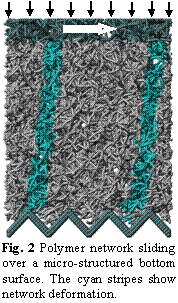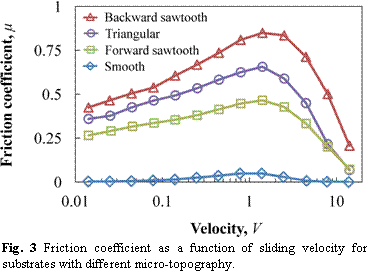57th Annual Report on Research 2012 Under Sponsorship of the ACS Petroleum Research Fund
Reports: DNI648911-DNI6: Using Soft Polymers to Regulate Friction Between Sliding Surfaces
Alexander Alexeev, PhD, Georgia Institute of Technology
The objective of the research is to study the frictional behavior of surfaces covered with soft polymer networks. To this end, we introduced a mesoscale computational model for gels, i.e. cross-linked polymer networks immersed in Newtonian fluids (Fig. 1). The gel model is based on dissipative particle dynamics (DPD), a coarse-grained molecular dynamics approach. Our three-dimensional, fully-coupled model not only captures the micromechanics of deformable polymer networks, but also accurately simulates the relevant hydrodynamic effects.
We have validated our methodology by comparing our results for transport through isotropic polymer networks with previously reported theoretical and experimental data. We found that your model can accurately describe the transport and mechanical properties in polymer networks. We have used the model to examine how the transport changes when the network undergoes mechanical deformations typical for rubbing surfaces. We found that the change of the transport properties can be described in terms of filament re-orientation due to network deformation. We have also used the model to probe the swelling kinetics of microgel particles and examine the release of solutes from responsive microscopic polymer carriers.
We employed our model for cross-linked polymer networks to study the frictional behavior of dry elastomers in relative motion against adhesive and non-adhesive surfaces (Fig. 2). We considered smooth substrates and substrates with microscopic triangular, forward and backward sawooth asperities. We examined the effects of velocity, temperature, normal load, and surface adhesiveness on elastomer sliding. Our friction simulations predicted a bell-shaped dependence of the friction coefficient on the sliding velocity in agreement with experimental observations (Fig. 3).
Our simulations revealed that the friction experienced on non-adhesive surfaces is the lowest for a surface with forward sawtooth asperities, while the surface with backward asperities leads to the highest friction (Fig. 3). For adhesive surfaces, our simulations showed that the friction force is independent of the surface geometry when the sliding velocity is relatively slow. The friction forces were shown to be related to the gradients of internal stresses that develop in polymer networks
We found that the velocity at which the friction is maximum depends on the system temperature for the hysteretic friction and is a function of the ratio between the thermal and adhesion energy for the adhesive friction. Moreover, our calculations indicated that at low sliding velocities, both hysteretic and adhesive friction decrease with an increase in the temperature. Finally, we showed that while the coefficient of hysteretic friction is nearly independent of the normal load, the adhesive friction coefficient exhibits an intricate relation with the applied pressure.
Overall, our findings shed light on the complex frictional behavior of elastomers and give useful insights into the effect of surface asymmetry and adhesiveness on the elastomeric friction. This information is important for developing new methods for regulating friction and reducing wear using directional surfaces. In addition, our simulations demonstrated that our coarse-grained particle-based computational model of viscoelastic networks can be effectively used to examine the influence of system parameters on elastomer friction. This enables the development of novel highly-efficient computational tools for the modeling and analysis of the complex tribological behavior of polymer networks.
This project trained one PhD student who is now a postdoctoral student in NYU. The results were published in 5 journal publications and were presented at a number of national meetings. Furthermore, the results from this project were used to prepare research proposals to NSF and ARO, including the NSF-CAREER proposal which is currently under review.













